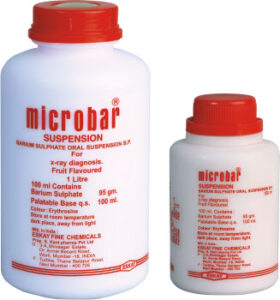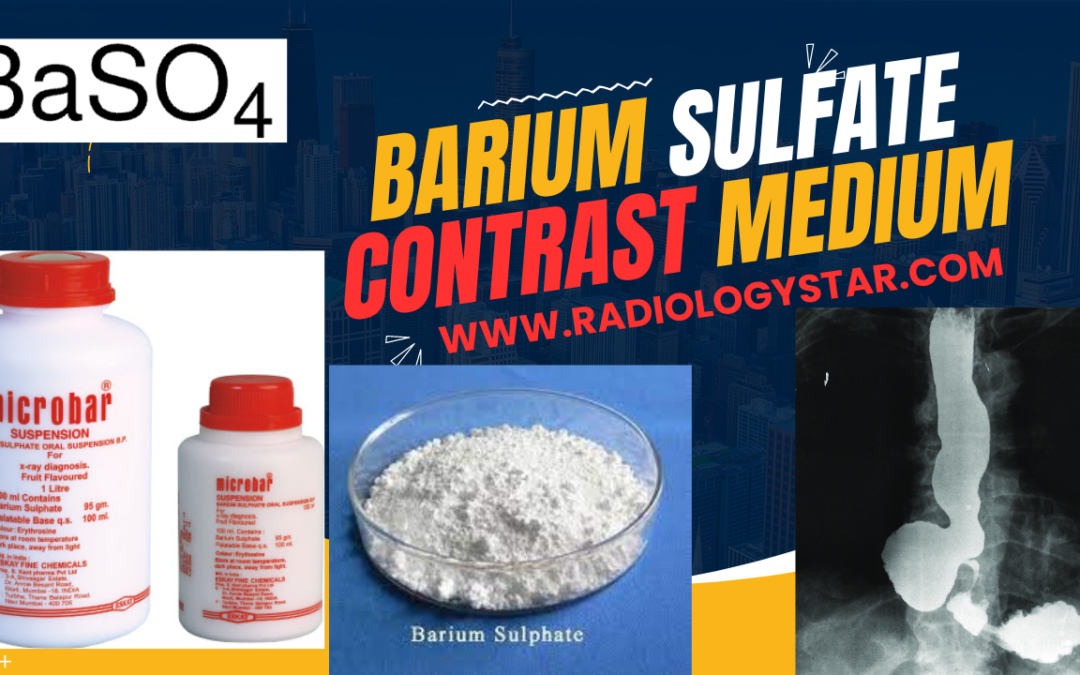What Is Barium Sulfate Contrast Medium?
Barium Sulfate Contrast Medium is a radiopaque contrast medium commonly used in medical imaging to visualize the gastrointestinal (GI) tract. It is particularly useful for examining the esophagus, stomach, small intestine, and large intestine. Barium sulfate is preferred in GI imaging due to its excellent opacification properties, providing clear delineation of the mucosal lining and highlighting abnormalities such as strictures, ulcers, tumors, and other pathologies.
Barium sulfate (BaSO4), often just called barium in radiology parlance, is an ionic salt of barium (Ba), a metallic chemical element with atomic number 56.

Chemical Composition Of Barium Sulfate Contrast Medium.
Barium sulfate (BaSO4) is an inorganic compound composed of barium, sulfur, and oxygen. It is a white, odorless, and insoluble powder that is not absorbed by the digestive system, making it safe for use as a contrast agent.
Mechanism of Action Of Barium Sulfate Contrast Medium
After ingestion or administration, barium sulfate coats the lining of the GI tract, providing a high-contrast outline of the mucosal surfaces. When exposed to X-rays or other imaging modalities such as fluoroscopy, barium sulfate absorbs and attenuates the x-ray beams, appearing white on radiographic images. This contrast enhancement enables the radiologist to visualize the shape, position, and function of the GI organs more clearly.

Indications Of Barium Sulfate Contrast Medium
Barium sulfate contrast medium is indicated for various GI imaging studies, including:-
A. Barium swallow (esophagram):- Evaluates the esophagus for conditions such as strictures, diverticula, and motility disorder
B. Barium meal (upper GI series):- Assesses the stomach and duodenum for ulcers, tumors, hiatal hernias, and gastric motility disorders.
C. Barium enema (lower GI series):- Examines the colon and rectum for polyps, diverticula, inflammatory bowel disease, colorectal cancer, and other abnormalities.
Contraindications Of Barium Sulfate Contrast Medium
A. known or strongly suspected gastrointestinal perforation, may be used in evaluation for possible esophageal perforations, see below
B. large volume aspiration risk
C. prior allergic reaction (rare)
D. left-sided colonic obstruction (relative contraindication)
E. if the barium cannot exit the colon, it has the potential to become inspissated and very hard, leading to a quite problematic constipation.
Complications.
A. Perforation:- The escape of barium into the peritoneal cavity is extremely serious, and will produce pain and severe hypovolaemic shock. Despite treatment, which should consist of i.v. fluids, steroids and antibiotics, there is still a 50% mortality rate. Of those that survive, 30% will develop peritoneal adhesions and granulomata. Intramediastinal barium also has a significant mortality rate. It is therefore imperative that a water-soluble contrast medium is used for any investigation in which there is a risk of perforation, or in which perforation is already suspected.
B. Aspiration:- Barium if aspirated is relatively harmless. Sequelae include pneumonitis and granuloma formation. Physiotherapy is the only treatment required (for both aspirated barium and LOCM), and should be arranged before the patient leaves hospital.
C. Intravasation:- This may result in a barium pulmonary embolus, which carries a mortality of 80%.
Adverse Reactions Of Barium Sulfate Contrast Medium
Adverse reactions to barium sulfate are rare but may include nausea, vomiting, constipation, abdominal discomfort, and allergic reactions. In cases of aspiration or perforation, barium sulfate can cause serious complications and may require immediate medical attention.
Safety Consideration
A. While barium sulfate is generally considered safe, there are certain precautions and contraindications to be aware of:
B. Patients with a history of barium allergy or hypersensitivity reactions should avoid barium sulfate contrast.
C. Special caution is necessary in patients with conditions such as perforation, bowel obstruction, or impaired swallowing reflexes.
D. Adequate hydration and post-procedure bowel care are essential to prevent complications such as barium impaction or constipation.
Advantages
A. The main advantage when compared to water soluble contrast agents is the excellent coating which can be achieved with barium, allowing the demonstration of normal and abnormal mucosal patterns.
B. Cost.
Disadvantages Of Barium Sulfate Contrast Medium
A. High morbidity associated with barium in the peritoneal cavity.
B. Subsequent abdominal CT and US are rendered difficult (if not impossible) to interpret. Patients may be asked to wait for up to 2 weeks to allow satisfactory clearance of the barium. If also required, it is advised that the CT and/or US be performed before the barium study.
BOOK LINK :- Textbook of Radiology for X-ray, CT, MRI, BSc, BRIT and MSc Technicians

